Sound recordings as documents of stylistic development are an integral part of jazz research. Being able to hear musical transformation and evolution over a period of years, or decades, is an essential tool for anyone endeavoring to study the music’s history.
However, recordings can be misleading and never taken solely at face value. For one thing, a chronology of early jazz recordings is not the same as a chronology of performance practice evolution. Because a jazz band recording from 1920 may sound stilted and underdeveloped does not mean that rhythmic sophistication did not exist before then. But, such sophistication on early recordings is rare.
Therefore, some of the most exciting moments in early jazz research occur when a nugget of recorded evidence emerges clarifying, supporting, or denying some of our assumptions about performance practice. One of my main interests in mining early recorded popular music has been finding performances of ragtime and “proto-jazz” that convey a sense of looseness and swing. Not “swing” in a Benny Goodman 1938 Carnegie Hall sense, but rather, a conversational flow to the music.
The heart and soul of early jazz is rhythmic freedom; the connective tissue between the notes is flexible, yet sharp. We might say that as a result, the notes “swing” rather than lurch.
However rare, there are some recordings of ragtime and vaudeville performers dating from the late nineteenth century through the mid-1910s that illustrate a loose, natural, swinging, or swaggering approach, exhibiting what author David Wondrich termed “Stomp and Swerve” in his 2003 book of the same title.
Nonetheless, most of the extant recorded examples of proto-jazz reflect not the flexible nature of jazz, but rather a self-conscious and inept understanding of the essence of “swing.” I cannot count the number of hours I have spent listening to recordings from that time period looking for nuggets. This underscores, emboldens, and highlights the importance of the Gus Haenschen Columbia Personal Records.1
I was introduced to the Haenschen Personal recordings in 1984, while going through a collection of 78s in a Pennsylvania record store. As I flipped through records in boxes, an item appeared with a pale grey label and type that was hard to read. It was a single-face pressing titled “Sunset Medley,” a piano solo with drums, played by Gus Haenschen, a white pianist, composer, and dance orchestra leader, who operated in and around his native St. Louis.2 He is accompanied by drummer T.T. Schiffer.
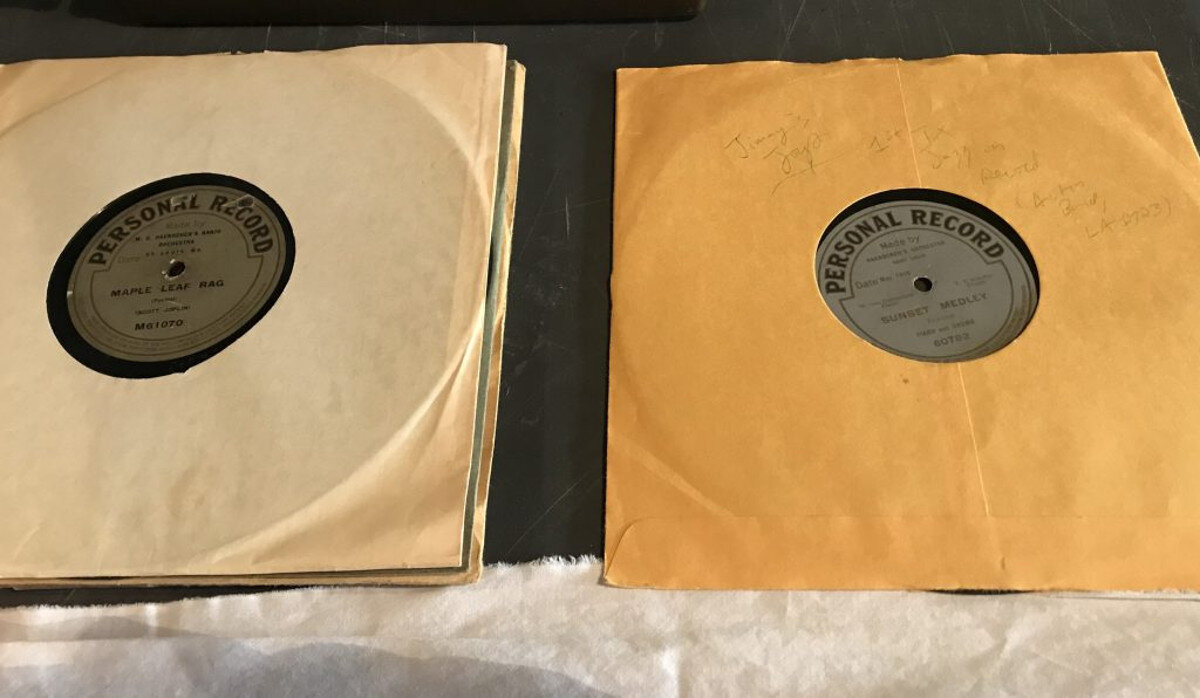
The recording date “May 1916” was printed on the label, an odd notation, for such information was rarely supplied on record labels in that era. I placed it on the record player at hand and nearly fell over: it was relaxed, yet driving, loose and—for the 1910s—swinging. One could definitely call it ragtime.
However, upon hearing it, the thought emerged that this could also be definitely called jazz, so spontaneous and emphatic was Haenschen’s playing. Additionally, the fact that it was recorded in May of 1916, nearly a year before the first verified jazz recordings, seemed reason to celebrate.
I purchased the disc for an enormous $2 and promptly brought to the attention of musicologist and jazz historian Thonton Hagert, a man not given easily to emotional display. He heard it and grew excited. It turned out that Haenschen was playing a portion of a published work, a medley titled “A Bunch of Blues,” composed by two black musicians J. Paul Wyer and Alf Kelly.
Haenschen follows “A Bunch of Blues” fairly closely, through its first two sections. It opens with a blues titled “The Weary Blues,” which is not the Artie Mathews work of the same name. It then segues into a familiar-sounding twelve-bar blues, titled “String Beans’ Blues,” which was composed and performed by pianist and stage performer Butler “String Beans” May, circa 1892-1917.3 “String Beans’” begins with an exciting descending motif, copied and repeated by many. It can be heard on many recordings, such as the introduction to “Walk That Thing,” by Charlie Johnson & His Paradise Band.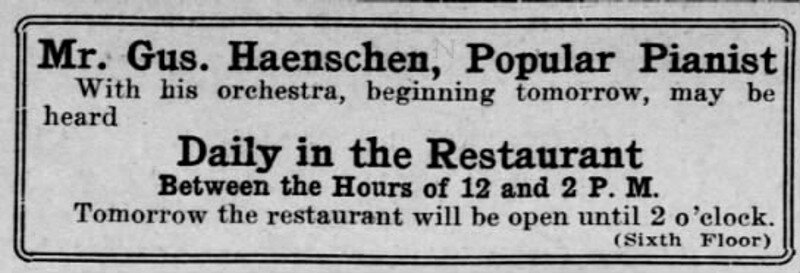
Following “String Beans’,” Gus jettisons “A Bunch of Blues,” and plays a familiar 16-measure strain that begins on the dominant 7 chord, not unlike, but not identical, to tunes like “Gate Mouth” or “Do What Ory Say.” This strain leaves several two-measure breaks for drummer T.T. Schiffer.4
At this point in the recording, Haenschen abandons blues and ragtime completely and settles into a two-chorus rendition of Jerome Kern’s tune “Babes in the Wood,” from the 1915 Broadway musical production Very Good Eddie. On the surface sedate, “Babes” is unrelenting in intensity from Schiffer and contains some fine touches from Gus, including an expert imitation of a mechanical Pianola as well as an exquisite 4-measure break near the end of the performance.
The important thing about all this lies in the performance and how Haenschen and Schiffer make it come alive. The printed notes of “A Bunch of Blues” are interesting, even compelling. However, the written note does not live until someone plays it. Haenschen’s performance douses us with bracing authenticity. He is not reading the music. Rather, he has internalized, memorized, and repeated it, with all the passion and intent of the black musicians from whom he learned.
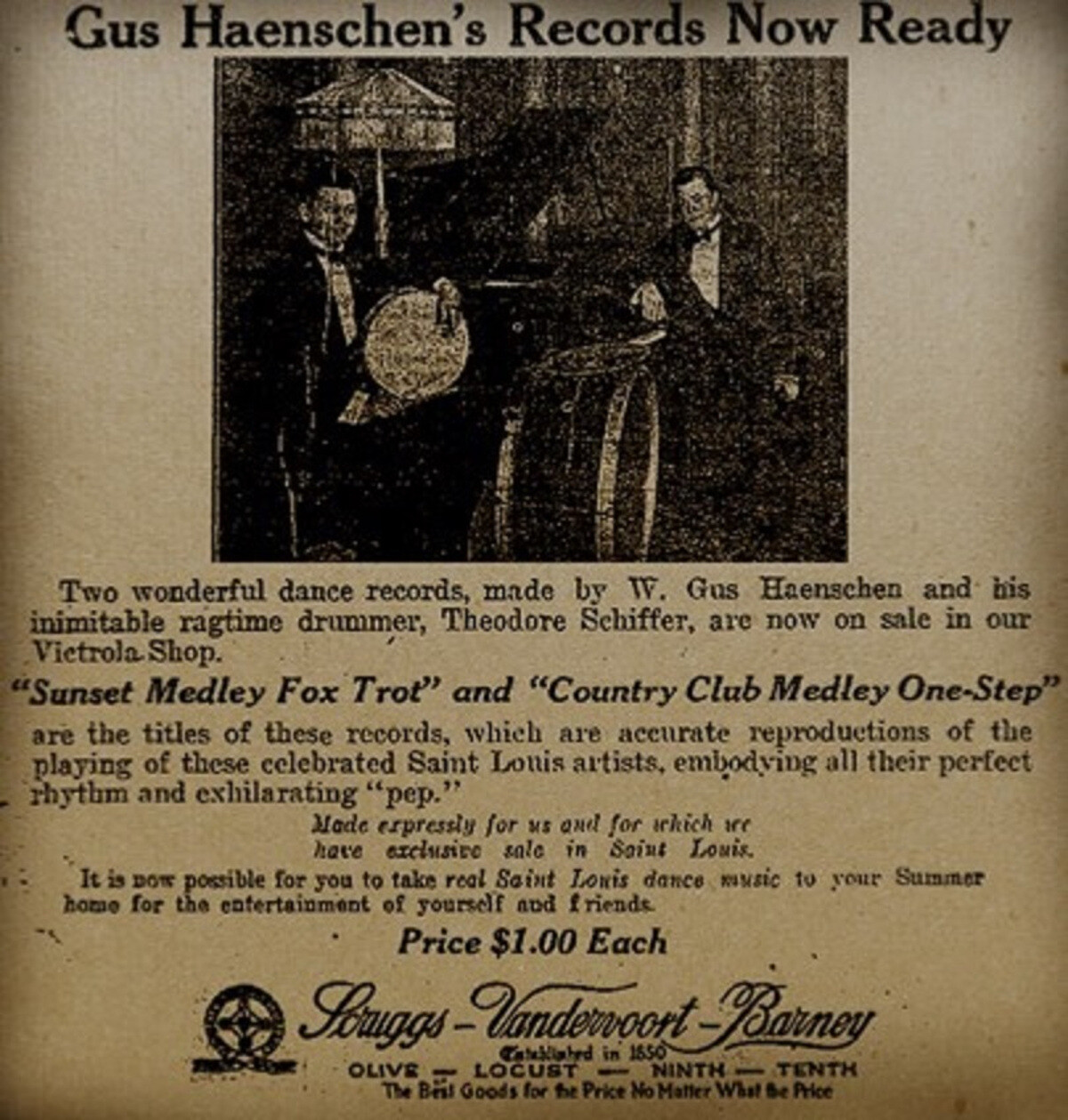 Most compelling is Haenschen’s rendition of the “String Beans’” theme. There is nothing quaint or anachronistic about this 1916 recording. It is as palatable and lands as easily on the ears as anything recorded by Jelly Roll Morton, Fats Waller, Ray Charles, or James Booker. Contemporaneous recordings of similar motifs, such as Clarence Williams’ “Brown Skin” were recorded by the Victor Military Band and (Charles) Princes’ Band, both in 1916. The stiffness displayed by those two ensembles is laughably light-years behind Haenschen’s swinging, stomping rendition.
Most compelling is Haenschen’s rendition of the “String Beans’” theme. There is nothing quaint or anachronistic about this 1916 recording. It is as palatable and lands as easily on the ears as anything recorded by Jelly Roll Morton, Fats Waller, Ray Charles, or James Booker. Contemporaneous recordings of similar motifs, such as Clarence Williams’ “Brown Skin” were recorded by the Victor Military Band and (Charles) Princes’ Band, both in 1916. The stiffness displayed by those two ensembles is laughably light-years behind Haenschen’s swinging, stomping rendition.
“Sunset Medley” is not the only recording made in 1916 by Gus Haenschen. Among the other gems are another piano solo—less hot, but fascinating all the same, and four by an ensemble termed Haenschen’s Banjo Orchestra, which consisted of two banjos—one of whom doubled on violin—trombone, piano, and drums. The two overarching significant facts about all of these recordings are the honest and relaxed performance styles and the fact that the majority of the works are by black composers. Given Haenschen’s Midwestern proximity to authentic ragtime, we should pay even closer attention to the musical communication transmitted in these recordings.
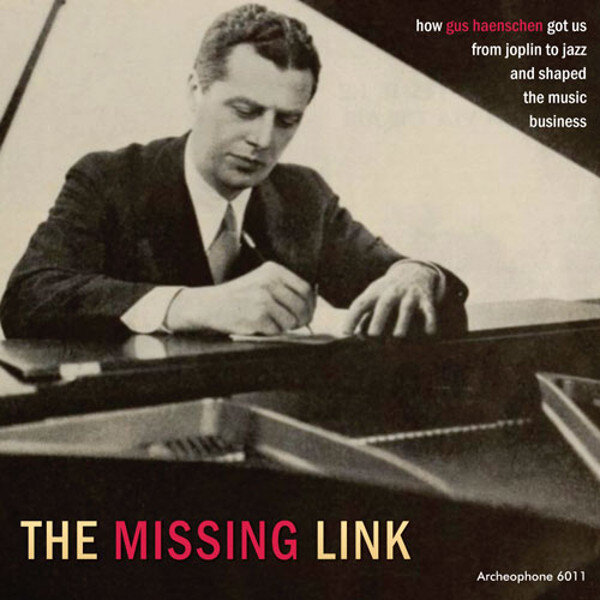 And now, there is less need to muse too heavily about this, because our friend, the young musician, collector, and “trad-jazz visionary” Colin Hancock has collected all six known Haenschen Columbia Personal recordings, along with supplementary recordings and interview material, for a brand-new release on the Archeophone label, titled The Missing Link: How Gus Haenschen Got Us From Joplin to Jazz and Shaped the Music Business. As a capper to these revelatory recordings, Colin reveals in the collection’s detailed notes that Gus Haenschen both knew and studied with Scott Joplin.
And now, there is less need to muse too heavily about this, because our friend, the young musician, collector, and “trad-jazz visionary” Colin Hancock has collected all six known Haenschen Columbia Personal recordings, along with supplementary recordings and interview material, for a brand-new release on the Archeophone label, titled The Missing Link: How Gus Haenschen Got Us From Joplin to Jazz and Shaped the Music Business. As a capper to these revelatory recordings, Colin reveals in the collection’s detailed notes that Gus Haenschen both knew and studied with Scott Joplin.
The Joplin connection is especially intriguing since one of the titles by the Banjo Orchestra is Joplin’s “Maple Leaf Rag.”5 Now, along with Jelly Roll Morton’s varied performances of “Maple Leaf” (both as composed and “St. Louis Style”) we have another version—one recorded during Joplin’s lifetime, by someone who actually knew him.
What this all comes down to is musicality, regardless of genre and regardless of style. Music, by nature, should be musical and intelligible. A sense of swing did not develop over decades of popular music evolution. Rather, it is as old as music itself. However, when mining early recordings for nuggets, we must remember that the recording industry was not necessarily going about capturing music for altruistic—or even artistic—reasons.
Also See: Move Over ODJB: Jazz Was First Recorded in 1916, by Colin Hancock
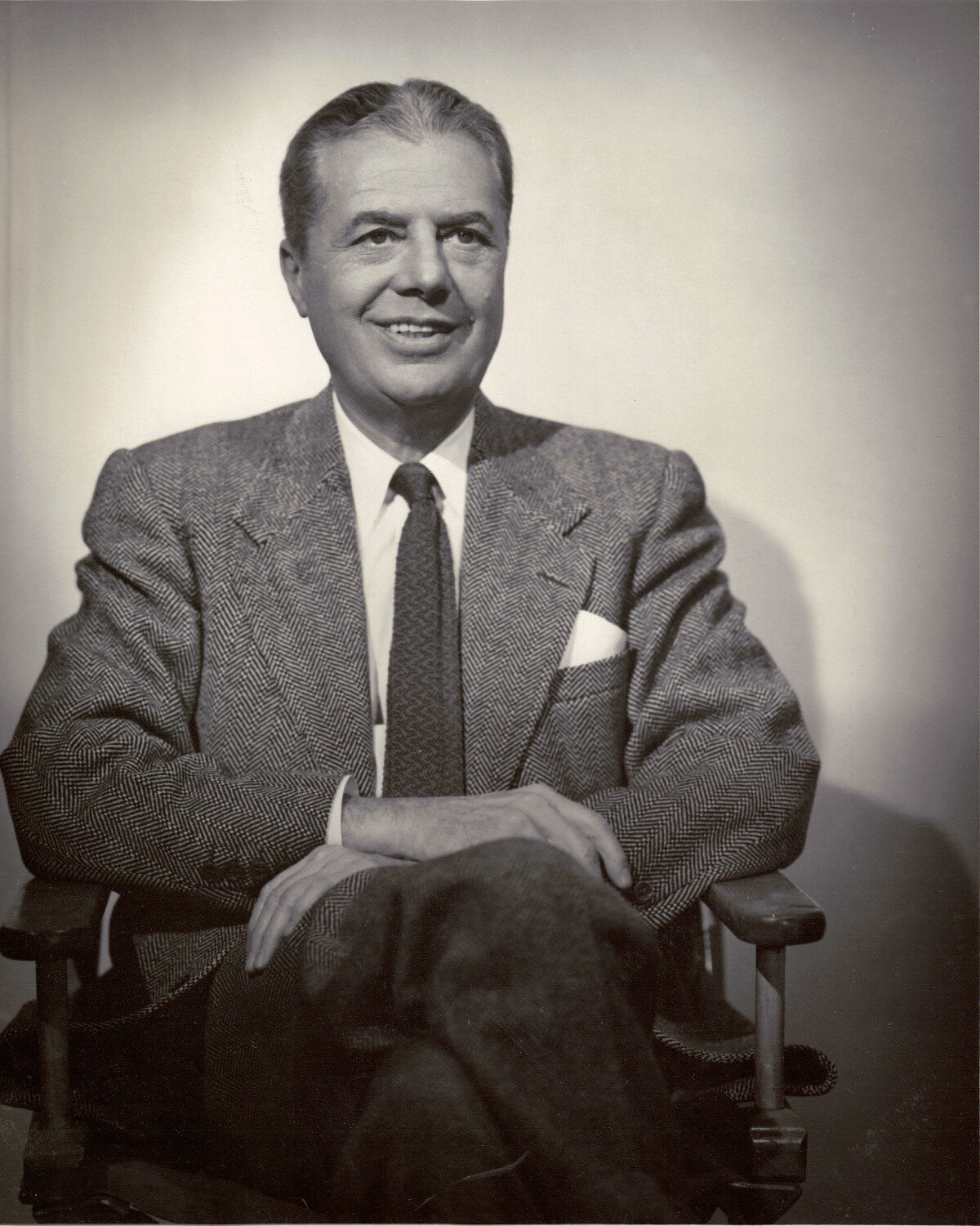
Notes:
1 The Columbia Graphophone company’s “Personal” label made recording accessible to amateurs and professionals who otherwise had no access to recording studios.
2 Haenschen, shortly thereafter, became the music director for Brunswick Records. He subsequently became a top radio maestro.
3 The important, fascinating, and sad story of Butler May is found in detail in the essential work, The Original Blues, by Lynn Abbott and Doug Seroff, published by university Press of Mississippi, 2017.
4 The performance is very much a duet. T. T. Schiffer’s heavily accented rudimentary-style snare drum and woodblock are in evidence throughout. Although Schiffer’s playing does not swing like Gus’s—it is nonetheless compelling; not unlike Buddy Gilmore’s work on the 1914 James Reese Europe recording of “Castle House Rag.”
5 For decades the recording date for “Maple Leaf” was thought to be 1910. Apparently, this was the result of discographer Brian Rust’s misreading of Helen Chmura’s handwritten notation in the Columbia archive; the “6” in 1916 looked like a zero.
David Sager is a jazz historian and a professional trombonist. He works in the Recorded Sound Research Center at The Library of Congress.






















